The Pathogenesis of a Genocide
TRANSCEND MEMBERS, 29 Jan 2024
Prof Hoosen Vawda – TRANSCEND Media Service
This publication contains graphic visuals, which may be disturbing to some readers. Reader discretion is strongly advised. Parental guidance is recommended for minors.
“In all Genocides, the Global Conspiracy of Abysmal Silence is most deafening and is indicative of governmental hypocrisy. It is a serious indictment on all of humanity.” [1]
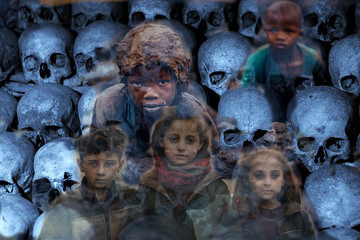
The Skulls and Ghosts of Child Victims of Rwandan and Palestinian Genocides, perpetrated by Imperialists, their puppets and Neo-Colonialists, in the present era.
Photo Credits: Rwandan Genocide Museum, Starving Children in Rubble of Gaza, Palestine with dehumanisation and murder of Children and Minors
Composite Digitisation by Mrs V. Vawda
“Genocide Demystified”.
This publication, contributes to the series of papers on Genocide, by the author.[2],[3],[4],[5],[6],[7],[8], It describes how genocides originate[9] , as the climax, in a series of peace disruptions on a nation or a large community, by the occupying oppressor in a conflict situation based on their ethnic differences, though not being the sole causative factor in the dislike of a particular group of humanity. While the term “Genocide”[10] was only coined in post-World War II in 1944 , the operational philosophy dates back to prehistory from ancient Egypt to the 21st century whereby it is still being practised in all its brutality, even today. Interestingly, genocide is practised, as a philosophy, on minority populations, which are followers of Islam, in its various forms, extending from China on the Uyghurs, towards the Rohingyas in Myanmar, through to Kashmir[11] by India and presently of an yet unknow, seen intensity and brutality of ongoing ethnic cleansing in Palestine by the Zionist government of Israel. Here, total annihilation of the Palestinians is the underlying intent of Prime Minister Benjamin Netanyahu’s[12], ultra-right wing, coalition, since 29th December 2022[13]. This ongoing brutality has resulted in the displacement of over 1.9 million Palestinians, and the deaths of nearly 25,000 civilians, mainly women and children, who are really no part of what the resistance fighters, justifiably do, in their fight to regain, what rightly belongs to them; their ancestral land from which they have been displaced by colonial imperialistic, collective Balfour Declaration[14] on 02nd November 1917, to house the mass of Jews in Palestinian land, following WWI.
This publication, further expands the term “genocide” as defined by Raphael Lemkin and the key components involved:
- Raphael Lemkin[15] was a Polish lawyer who coined the term “genocide” in his 1944 book “Axis Rule in Occupied Europe.”[16] He defined it as “the destruction of a nation or of an ethnic group.”
- Lemkin’s definition focused on the intent to systematically destroy a group, rather than just killing individuals. This includes actions intended to eliminate essential foundations of life for the group such as culture, language, economic existence, and more importantly their racial identity, for ever, including the destruction of their ancestral homes.
- Key components involved in the “pathogenesis” which examines the origins and or development, of genocide per Lemkin’s framework include:
Dehumanisation of the victim group
Ideologies and propaganda promoting the inferiority of the victim group
Drive to eliminate threat posed by victim group’s existence
State-organised action against victims, including mass murder, deprivation, starvation, deportation
To educate further on how this understanding of genocide pathogenesis has played out in the 21st century, it is relevant to present specifics on which modern genocides or case studies are analysed. There have unfortunately, been several genocidal campaigns based on ethnic, national, racial and religious divisions, even in recent decades, as stated above. The Tigray Genocide[17] in Ethiopia is an example. It is necessary to examine, what was the pathogenesis of that genocide? he ongoing crisis and violence in Ethiopia’s Tigray region is a tragic case that can be analysed through the lens of Lemkin’s framework on the pathogenesis of genocide:
Background:
- Tigray is an ethnic region in northern Ethiopia, with a population of about 6 million Tigrayans
- Tensions escalated between the Tigray People’s Liberation Front (TPLF) and the Ethiopian federal government led by Prime Minister Abiy Ahmed[18]
Dehumanization & Inferiority Narratives:
- Rhetoric emerged from Abiy’s government and supporters painting the Tigrayans as treasonous, criminal and even “weeds” needing to be pulled out
- State media propagated images of Tigrayans as backwards peasants needing to be brought under control
Drive to Eliminate Threat:
- The TPLF[19] posed a political threat after Tigray held regional elections in defiance of the federal government
- The federal government views the Tigrayan identity & autonomy as threatening Ethiopian unity
State-Organised Action:
- In Nov 2020, Abiy, a previous Nobel Peace laureate, ordered a military offensive against Tigray, with support from Eritrea’s military
- Widespread reports of indiscriminate killings, sexual violence, deprivation and forced starvation
Therefore, systematically dehumanising the Tigrayan ethnic group, promoting the need to control their autonomy, and directly ordering military action that destroys foundations of life, the crisis exhibits components of Lemkin’s pathogenesis of genocide definition. A humanitarian disaster is still unfolding with millions displaced and denied access to aid. This analysis helps illustrate how Lemkin’s genocide framework tragically applies in an ongoing 21st century context. However, it is necessary to present an overview of some of the most common causative factors that unfortunately underpin almost all modern genocides and campaigns of mass ethnic violence.
As the scholar Raphael Lemkin established in coining the very term “genocide” in the 1944, such outrages against human life and dignity do not occur spontaneously, but rather follow a disturbing yet recognisable pathogenesis. Specifically, the road to genocide is often paved by a dangerous interplay of dehumanization, threat construction, and state-sanctioned violence. Across global history, we tragically see this pattern emerge in very different cultural contexts. It begins with campaigns of misinformation and propaganda, inciting hatred by portraying minority communities as not fully human, a fundamental threat to social order and progress. Currently, Americans and the Western bloc categorise them as “terrorists” when these individuals have been forced into organising themselves into armed factions, to claim, their dispossessed land, which rightfully belongs to them in the original context. It is ironical, that when United States invades Afghanistan or Iraq, by repeated aerial bombings as it did in Cambodia in the past, they are called liberators, in spite of the mass killings and maiming they cause, yet armed factions, fighting to regain their own land, as it was in preliberation South Africa, are classified as terrorists, by the same oppressive, colonial neo-imperialists. This lays the psychological groundwork amongst the populace to justify and even participate in state policies aiming to oppress, purge, and annihilate the constructed threat. From the Holocaust, to Bosnia, to Rwanda, to the ongoing anguish in Xinjiang, Rohingya, and Tigray, the preamble of dehumanisation and fear precedes organised action by authorities to forcibly remove and eradicate. No society or ethnic group has a monopoly on virtue when instability takes hold. The author highlights research on the specific ways these factors, dehumanisation, threat construction, and state sanctions of violence, structurally recur across modern genocides. The author’s aim is to present a thoughtful and robust dialogue on the global challenges of pluralism and differential justice, as well as our collective responsibilities as citizens, amid such continued atrocities, worldwide.
It is necessary to examine what exactly motivated Lemkin to coin the term genocide. Raphael Lemkin devoted much of his career to understanding and advocating against the crime of genocide, largely motivated by his own experiences and background: Lemkin was born in 1900 to a Jewish family in Eastern Poland. As a young lawyer in the 1930s, he was alarmed by the rising threat of Nazism and Hitler’s public speeches targeting Jews and other groups for destruction. From as early as 1933, he sought to warn the international community that laws were needed to protect groups from this type of state-sponsored annihilation. Tragically, Lemkin lost 49 family members during the Holocaust[20] – the systemic genocide perpetrated by the Nazis across Eastern Europe with devastating efficiency. Studying the Nazi occupation policies, he noticed a patterned effort to undermine cultural institutions, religious life, education, and livelihoods of Jews and other minority groups in tandem with mass killings.
In 1944, while in exile in Sweden and feeling helpless amid his family’s suffering, Lemkin published his seminal text “Axis Rule in Occupied Europe” coining and defining the term “genocide.” He derived the word from the Greek (genos = people, race or tribe, a specific gene pool or genome, as subsequently discovered; cide = to kill). Genocide for Lemkin encapsulated the unique horror of state-driven attempts to methodically destroy communities as a whole, including their foundations of life and culture beyond just individual deaths. Later assisting prosecutors at the Nuremberg Trials of Nazi leaders, Lemkin lobbied tenaciously for the new legal concept of genocide to be incorporated into emerging human rights law after 1945. His advocacy helped drive the 1948 UN Convention on Genocide[21], finally enshrining protections he had argued for years earlier. In essence, Lemkin’s personal connection to the atrocities of the 1930s-45 motivated his pioneering push for the concept of genocide in international law. His experiences made clear that new frameworks were needed to describe and prosecute such state-driven destruction of ethnic, national, and minority groups. Ironically, such events, including inflammatory public rhetoric, are generated by the senior government officials of Israel, against Palestinians, even presently and the ICJ circus as witnessed on the 11th and 12th January 2024[22],[23] denies such anti Palestinian sentiments openly stated by Benjamin Netanyahu and his war cabinet.
Regarding Lemkin, himself, here is no evidence that foul play or unnatural causes were suspected in Raphael Lemkin’s death at the age of 59 in 1959. By most historical accounts, Lemkin had struggled with health issues for several years leading up to his relatively early passing. He was reported to have suffered from high blood pressure and related heart problems from extended periods of intense stress and overwork earlier in his career. In the years just before his death in 1959, Lemkin continued to teach internationally and speak fervently on human rights causes while likely managing chronic conditions. However, his health appears to have declined sharply in his late 50s. Eyewitness accounts suggest Lemkin collapsed suddenly while working at an office at Yale University in August of 1959[24]. Doctors at the hospital were unable to revive him after the collapse and he was pronounced dead shortly thereafter. While the loss of this visionary human rights advocate so shortly after his tireless crusade on legal frameworks against genocide is certainly tragic, there are no recognized accounts that foul play was ever considered or investigated as the cause of Lemkin’s death. It is broadly classified by history as most likely relating to the lasting effects of significant health challenges he experienced as a driven legal scholar and political refugee for much of his shortened but hugely impactful career life.
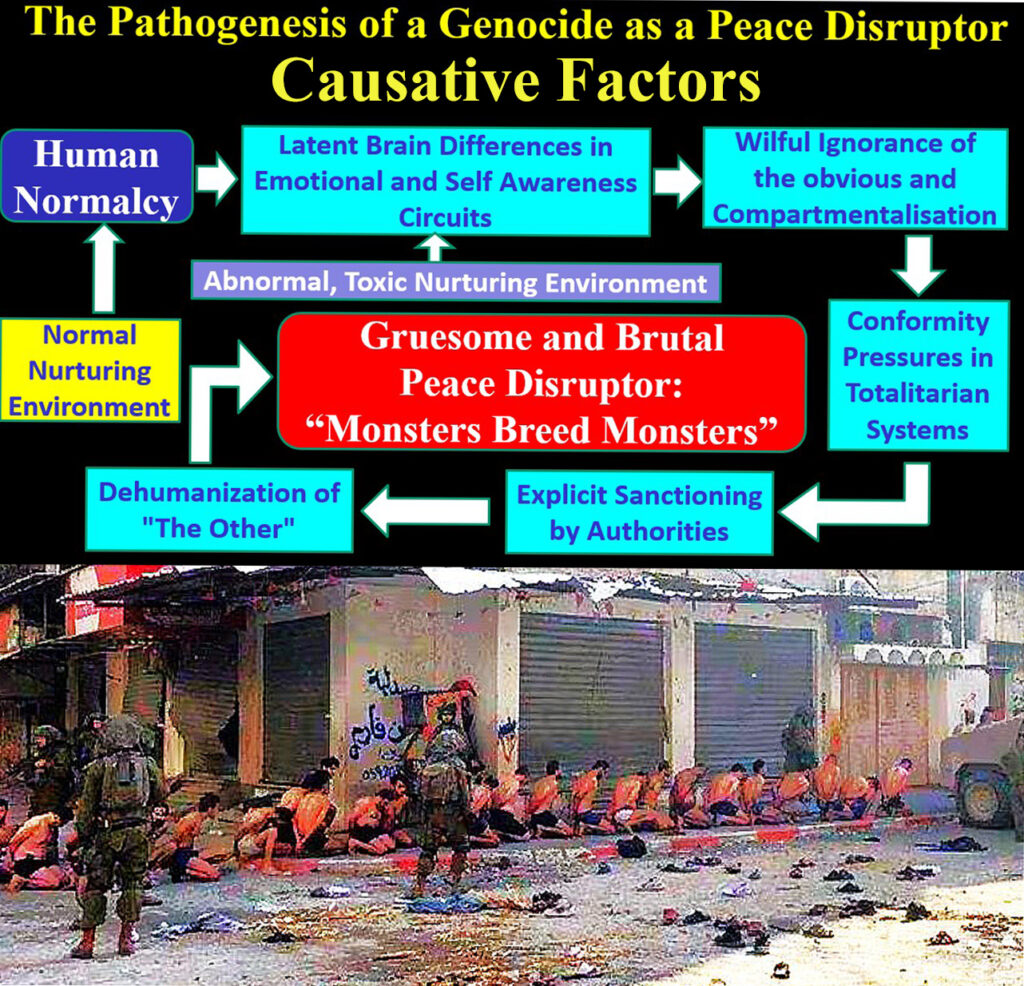
Graphic Top: The Generation of a Genocide indicating the Causative factors in a flow chart
Credit: Designed by Mrs. V. Vawda, January 2024
Photo Bottom: Dehumanisation of Civilian Palestinians shown in underwear, arrested by Israeli Forces. Captured and detained Palestinians sit on a street in Beit Lahia, northern Gaza Strip, as Israeli soldiers stand guard, amid the ongoing ground operation of the Israeli army against Palestinian Islamist group Hamas.
This handout image obtained by Reuters on December 8, 2023.
What are the key factors for any killings to be classified as a genocide as per the Convention definitions?[25]
According to the United Nations Genocide Convention adopted in 1948, there are key factors that distinguish the legal definition of genocide from other forms of mass violence or killings:
- Intent to destroy: There must be a deliberate, intentional attempt to physically destroy an entire racial, ethnic, national or religious group, in whole or in part. The goal is the eradication of their existence.
- Targeting of protected groups: The victims or those targeted must be recognized groups protected by the Convention – national, ethnic, racial or religious groups. Killings based on political beliefs or other criteria do not qualify.
- Scale of destruction: The actions must aim to destroy a substantial portion of the group and their foundations to sustain communal life. Isolated hate crimes may still be reprehensible, but do not fit the systematic, widespread attempt to annihilate that defines genocide.
- State-organised action: Perpetrators with genocidal intent often include state actors, regimes, or occupying authorities organizing or enabling actions of mass violence against the victim group through their policies. However, the Convention recognizes that some non-state actors can still commit genocide.
In summary, the key factors per international law are the provable intentional, targeted attempt to systematically destroy the existence of protected national, ethnic, racial or religious groups. This is the precedent set by the UN Genocide Convention that emerged from the horrors of the Holocaust that had motivated Raphael Lemkin to coin the term to begin with. Identifying and proving genocide remains complex, but it undeniably remains an all too real part of the modern world. Raphael Lemkin left behind an incredible legacy for both the legal community and human rights advocates worldwide:
Legal Fraternity Legacy:
- Coined the term “genocide” and provided the first comprehensive definition of this crime – crystallizing the concept legally
- Laid the fundamental framework for formally prosecuting genocide under international law at the Nuremberg Trials
- Pioneered new thinking in international law – getting it to recognize group rights and that cultural/physical destruction of ethnic groups is a crime
- Drove the adoption of the 1948 UN Genocide Convention defining and codifying genocide after years of his advocacy
- Set key legal precedents for holding states accountable for oppression of groups within their borders
- Established a voice at the forefront linking past wartime atrocities to human rights legal architecture for the future
Human Rights Legacy:
- Enshrined the rights of vulnerable minority groups in fundamentally new ways after WWII
- His concept of genocide shed moral light on the horrors of state-sponsored dehumanization and destruction of peoples
- Powerfully influenced the growth of post-war human rights discourse and institutional norms
- Shaped later humanitarian concepts like “ethnic cleansing” and frameworks for crimes against humanity
- Inspired and equipped human rights lawyers for decades with the lexicon to describe cultural/physical decimation
In essence, Lemkin profoundly expanded the moral and legal imagination around protecting marginalized groups from physical and systemic violence by states or occupying powers. His uncommon analytical skill paired with fierce compassion cemented genocide as both a historical lens, and standard enshrined in codes of ethics and law around the world.
A question often raised, is that would the war in Ukraine be classified as a Genocide? Based on the information currently available, most legal experts would argue that Russia’s war in Ukraine does not meet the formal definition of genocide[26] as codified in international law. However, there are debates around certain aspects that may point to an intent by Russia to destroy elements of Ukrainian identity. A brief analysis:
Key Reasons it likely does not qualify as genocide:
- There is no clear evidence of a Russian policy deliberately seeking to physically destroy all or a substantial part of the Ukrainian national or ethnic group itself. The war likely recognizes Ukraine will continue existing.
- It appears to be primarily a war to conquer territory and assert geopolitical control. As egregious as war crimes being committed are, the military campaign itself does not seem defined wholly by the goal of erasing Ukrainians.
Areas that raise questions around genocidal patterns:
- Mass deportations, culture destruction and forced adoption policies in occupied areas controlled by Russia do mirror aspects of “cultural genocide” strategies. There are still questions on the systematic nature of these actions.
- President Putin refuses to acknowledge a unique Ukrainian identity separate from Russia – but it’s unclear if this translates to a policy of comprehensive physical destruction per the genocide definition.
In essence, while extremely horrific war crimes and tragedies have unquestionably occurred in the Ukraine invasion, most legal interpretations would still fall short of declaring it a systematically executed genocide by the standards of the UN Convention pioneered by Lemkin. But reasonable scholars argue certain disturbing genocidal tendencies may be emerging among Putin’s long-term occupation plans.
The Sri Lankan military’s brutal campaign against the Tamil Tigers rebel group at the end of the country’s decades-long civil war, presents another complex case when assessed against the UN genocide convention’s legal definition and criteria[27]:
Reasons why it likely does NOT constitute genocide:
- The violence was primarily targeted against the Tamil Tigers as an armed separatist group rather than the wider Tamil ethnic or national group as a whole.
- While extremely heavy-handed and causing massive civilian deaths, the stated goal seemed to be eliminating the Tamil insurgency militarily to preserve national unity, rather than explicitly destroying Tamil ethnicity within Sri Lanka.
However, strong counter-arguments have been made that genocidal acts were committed:
- Indiscriminate attacks knowingly and disproportionately targeted the Tamil civilian population concentrated in Tiger-held areas during 2008-2009. The high civil casualties likely far exceeded military necessity.
- Post-victory policies involved involuntary detention camps overwhelmingly targeting Tamil civilians with systematic abuses – aiming to punish the group rather than just suspected rebels.
In summary, while a very difficult case, the balance of evidence and Sri Lankan state interests point more towards this being an excessively brutal counter-insurgency military campaign rather than genocide. However, it certainly involved extreme state-sponsored human rights and international humanitarian law violations approaching genocidal thresholds even if a strong legal justification remains challenging.
However, there is very strong evidence and widespread agreement including among top UN officials and genocide scholars that the Myanmar military’s campaign against the Rohingya[28] people since 2016 amounts to genocide under international law.
The key factors that support it being classified as a genocide include:
- Explicit dehumanising intent – Myanmar officials have referred to Rohingya as “pests”, denied their ethnic identity as native to Myanmar, and stripped rights.
- Mass atrocities – Violence including mass killings, rape, forced displacement was deliberately and systematically directed at Rohingya civilian centres by security forces starting in 2016. Over 43,000 killed by 2021 estimates.
- Group destruction – Over 700,000 Rohingya fled into Bangladesh due to violence, while hundreds of villages were burned to prevent return. Explicit policy exists to reduce Rohingya populations and birth rates in Myanmar, per Human Right Watch.
- State involvement – The military leadership, local authorities, police, civilian militias assisted in driving out the ethnic group under direction of central state.
In totality, evidence points to a deliberate state-backed campaign targeting the foundations of life and identity of the Rohingya community with the goal of removing them from Myanmar territory. This matches the key legal criteria and definition for genocide crafted by Lemkin. Most international analyses thus unambiguously categorise the Rohingya persecution as an ongoing genocide.
The situation is China indicates that the predominant evaluation by various human rights groups and legal experts, is that China’s policies targeting the Uyghur population in Xinjiang [29]also amount to an ongoing genocide as per the United Nations definition.
The key factors supporting the classification of Chinese state actions against Uyghur people as a genocide include:
- Explicit Dehumanization: Official Chinese rhetoric describes assimilation of Uyghur identity into Han dominant ethnicity as “a cancer” that must be eradicated and treated.
- Extensive System of Concentration Camps: Over 1 million Uyghurs have undergone forced detentions, indoctrinations, sterilizations aimed at population control in state-funded facilities.
- Destruction of Group Life Foundations: Widespread levelling of Uyghur mosques, cultural sites and historical districts erases markers of identity systematically. Children also forcibly separated to dilute minority culture.
- Direct State Involvement: Persecution and forced assimilation policies are officially adopted by the Chinese Communist Party leaders and legislature as approved avenues for addressing Xinjiang.
While some states remain reluctant to rebuke China, key international legal analyses conclude that the degree of coordinated state action to “break [Uyghur] lineage” and “free” them of religious belief meets the definition of an order-of-magnitude attempt at genocide by the Chinese regime.
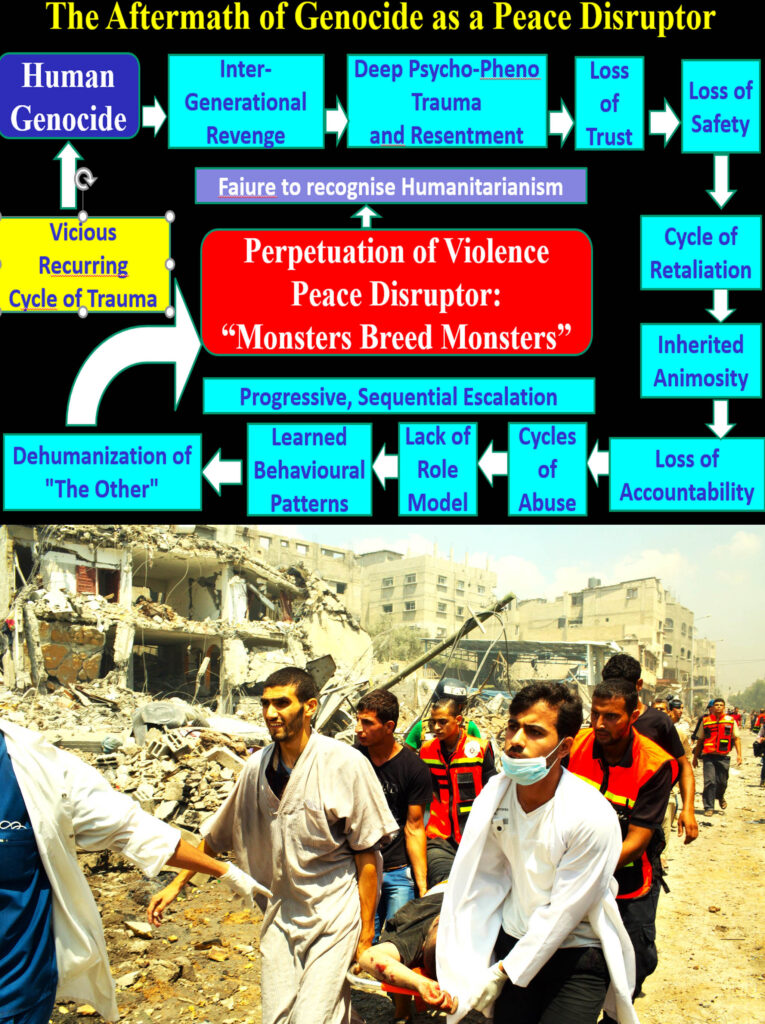
Photo Top: The Intergenerational Sequalae of Genocide as a Ongoing Peace Disruptor
Credit: Graphic Designed by Mrs V. Vawda; January 2024
Photo Bottom: A Palestinian is carried with severe injuries following Israeli Bombings in Gaza.
Photo Credit: New York Times.
Classification of the Preliminary Stages leading up to a Formal genocide[30]
Based on patterns across some of history’s most horrific genocides, there appear to be some common preliminary stages of persecution and dehumanization that lay the groundwork psychologically and legally to enable the eventual mass killings and destruction that define a genocide under international law:
Early Warning Signs:
- Classification and Symbolisation: The victim outgroup starts being defined and singled out, marked either literally with insignia like stars/badges or symbolically through recognizable traits made salient. This starts creating the “other”.
- Discrimination: The classified outgroup faces growing discrimination in daily civic and economic life, with loss of rights and status. This escalates an “us vs them” societal divide.
- Dehumanisation: Hate propaganda begins circulating via speech, media, and culture that paints the victim group as sub-human, vermin-like, a disease or threat needing to be suppressed or cured through radical means. The outgroup identity is denied.
- Isolation and Concentration: The targeted group forced into physical isolation into certain sectors, districts or even preliminary detention centres ahead of eventual transport to death camps during full genocide. Radical plans start formulating.
- Polarization: Moderates start falling silent while extremist voices grow, accelerating demands for action against the scapegoated outgroup blamed for social ills. Few dissent amid fear or complicity.
In summary, the Red Flags for future Genocide are growing visible separation, animosity, rights violations directed at the eventual genocide victim group provides warning signs foreshadowing the later plans for outright annihilation by the orchestrating power. Early intervention requires heeding these disturbing themes manifesting through social institutions. Based on the Holocaust, as the biggest Genocide, in recent history, the following are the steps on genocide as the “Final Solution”. the Holocaust stands out as the most extensive and devastating genocide in modern history, with the Nazi’s monstrous “Final Solution” policy systematically killing 6 million Jews and millions of other targeted groups. Building on the early warning signs of genocide I outlined already, here are the specific later stages of escalation in the case of the Holocaust:
- Expropriation: Jewish property, assets, and wealth were increasingly systematically seized or transferred to German/Aryan institutions under discriminatory laws all through the 1930s as their rights were revoked.
- Deportation and Isolation: Major campaigns of forced relocation of Jews into designated, walled-off urban ghettos escalated from 1939-1942, in parallel with arbitrary arrests sent to concentration camps amid worsening deadly conditions.
- Mobile Killing Squads: Einsatzgruppen paramilitary death squads began mass shooting operations across occupied territories in Eastern Europe and Russia, killing over 1 million Jews and Roma before implementing wider extermination infrastructure.
- Extermination Facilities: Vast network of dedicated death camps with gas chambers and crematoria were constructed by 1942 under “Operation Reinhard” to enable industrialized killing of up to 15,000 victims daily at peak. Genocidal intent clear.
- Forced Death Marches: As Soviet armies closed in, the Nazis marched tens of thousands of camp prisoners on routes where many were shot or succumbed to exposure, seeking to hide evidence before camps were liberated from late 1944.
In essence, the Nazis followed a terrifying step-by-step escalation from legalized discrimination up to the horrific mass murder infrastructure of the Holocaust at a scale even more sinister than prior historical genocides targeting groups on ethno-religious grounds. The world vowed “Never Again”, but tragically genocide has recurred since and exactly, the same processes, in much more brutally refined states are being used presently by Israel against the Palestinians, whereby, even their homes are systematically demolished by the occupation forces, demolition squads, affecting the entire families of so-categorised terrorists, who in reality are individuals who are fighting for their rights. In addition, Israeli Zionism is systematically starving the displaced Palestinians to death, by prevent access to basic foreign aid from reaching Palestinians, including food, water and medical supplies.
In addition, it is relevant to discuss some preventative strategies for Genocides to occur. Proactive strategies should be undertaken by 1. By the oppressed and 2. By the oppressor in obviating genocide from the early RED FLAGS IN GENOCIDES. Essentially, there needs to be action taken at two levels to prevent the early warning signs from snowballing into full-fledged genocide, with intent, against a targeted group:
Suggested Strategies for the Oppressed Group:
- Increased Group Solidarity: Band closely together across community divisions to unify around shared identity under threat. Build connections supporting resistance.
- Active Allies Outreach: Vigorously appeal to sympathizers abroad and international civil society to amplify reality of incitement to external powers who can apply pressure.
- Strategic Civil Resistance: Where possible, coordinate non-violent mass mobilization campaigns or low-level defiance against mounting rights restrictions imposed early on by the oppressive regime. Raise costs.
- Preserve Cultural Memory: Ensure heritage, stories, diversity of targeted group lives on despite cultural erasure attempts through decentralized education, art, language programs to sustain identity.
Strategies for Potential Oppressors:
- Avoid Dangerous Rhetoric: Prevent use of dehumanizing propaganda against any group, prohibiting spread of harmful stereotypes in public discourse that could be later weaponized if conditions shift.
- Uphold Equality Before the Law: Protect equal rights, social status, and dignity for all vulnerable minorities early on rather than introducing legislation that differentially discriminates against certain identities.
- Track Hate Groups Activity: Closely monitor for extremist mobilization, especially any that have capacity and motive to incite violence against an outgroup already facing discrimination.
- Set up Genocide Prevention Office: Establish an agency studying lessons from history to monitor early patterns of persecution, give policy guidance to diffuse intergroup tensions through systemic reforms.
These strategies aim to address hate and supremacy early on while empowering threatened groups to resist campaigns positioning them as the “enemy within” during the preliminary stages that set the stage for possible subsequent massacres. Responsibility on both sides to avert the genocidal path. It is strikingly necessary for a thorough overview and analysis of Raphael Lemkin’s crucial historical contributions along with the complex issues surrounding patterns of genocide pathogenesis across different global contexts, in the past and present. Highlighting Lemkin’s foundational framework regarding the stages, roots and legal definition of genocide as a state-driven “destruction of a nation” is an anchoring lens. It is mandatory to apply that to case examples like the Holocaust evolution, as well as ongoing ethnic crises in places like Myanmar and Xinjiang that still betray the bitter lessons of history. Analysing where prevention strategies have failed or require revival keeps this matter distressingly relevant to unpack such a sadly sobering but vital subject, affecting Peace Loving Humanity. These are critical strategies which universal “Peace Propagators” law makers, governments and indeed politicians must be familiar with and tirelessly try to continually revive and propagate to obviate destruction of humanity, in the future, globally. We collectively must understand and propagate the South African philosophy of Ubuntu. “I am because you are”. Rhetoric such as “America First” and philosophy of “Trumpism” must not only be neutralized, but totally avoided in the present-day context, in order to maintain global peace.
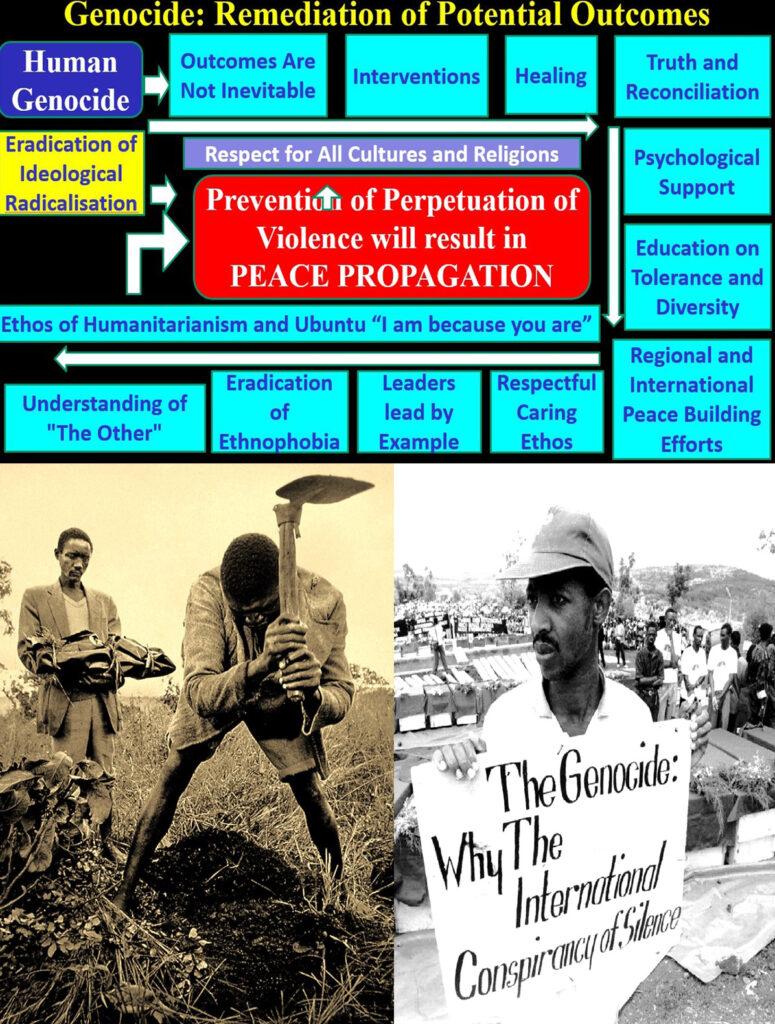
Photo Top: Flow Chart showing the stages in the Process of Remediation of the Potential outcomes of Regional Genocides
Credit: Graphic Designed by Mrs V. Vawda
Photo Bottom Left: Rwandan Genocide, 100 days of Continuous Slaughter from 06th April 1994 to 18th July 1994. Parents Burying their deceased child.
Photo Bottom Right: The Typical Abysmal Silence of the International Community in all Genocides, regarding the mass killings. In the Gaza Genocide, only South Africa lodged a case at the ICJ on 29th December 2023, against Israel.
The Bottom Line is that the current concept of Genocide is widely based on Raphael Lemkin original formulation. Raphael Lemkin had a remarkable personal history, and made even more extraordinary contributions to the field of international law:
Background
- Born in 1900 to a Jewish family in Poland (then part of the Russian Empire)
- Developed an interest in linguistics and philology as a university student in the 1920s
- Earned a Doctorate in Law from the University of Lvov in Poland in 1926
Early Legal Career:
- Practiced as a lawyer in Warsaw throughout the 1930s
- Repeatedly appealed to League of Nations to outlaw the destruction of cultural/ethnic groups
- Escaped Nazi-occupied Poland in 1941 and arrived as a refugee in the United States in 1941
Coining “Genocide”:
- Published his ground breaking work “Axis Rule in Occupied Europe” in November 1944
- First defined the term “genocide”, combining Greek term “genos” (race or tribe) and Latin term “cide” (to kill)
- Dedicated the book to his parents, who were among the millions of Jews murdered in the Holocaust
Later Career:
- Taught law and political science at universities in America in the 1950s
- Played a key role in the drafting of the UN Genocide Convention adopted in 1948
- Passed away rather unexpectedly in New York City in August 1959 at the age of 59
Legacy:
- Credited for enshrining the criminalization of genocide in international law
- Awarded posthumously with high honours from multiple countries for this lasting impact
- The Raphael Lemkin Center for Genocide Prevention was founded in his memory in 1998
In summary, while Lemkin had a relatively short career, his pivotal analysis of occupied Europe and tireless advocacy introduced the legal architecture to prosecute genocide long after his passing. His life’s work was clearly shaped by personal tragedy and the horrors inflicted during World War II. However, presently, Lemkin’s legacy has had absolutely no effect on the ongoing genocides in current history. Despite Lemkin’s ground breaking legal frameworks against genocide codified in the 1948 UN Convention, we tragically continue to see recurring genocides and ethnic cleansings across global conflicts today. There are a few reasons this remains the case:
- Geopolitical Obstacles – Lemkin pioneered the moral architecture to prosecute genocide, but major powers often obstruct interventions when its not aligned to national interests or threatens alliances. Global action requires consensus among self-interested states.
- Weak Enforcement Mechanisms – The genocide convention relies on the UN Security Council to activate investigations/interventions. But lack of political cohesion among 5 permanent members creates inertia amid rapidly unfolding crises.
- Culture of Impunity – Authoritarian regimes and militant groups have repeatedly flouted genocide laws knowing international will to intervene militarily remains weak, especially when major powers remain silent. Justice is seldom served.
- Conflicting Evidentiary Burdens – Even with strong suspicion, proving “intent” to annihilate ethnic groups beyond doubt per legal definitions is difficult when access is blocked. Regimes exploit legalistic burdens.
In essence, while Lemkin expanded laws on the books, the gap persists between legal theory and operational capacity to respond amid murky, dangerous conflicts. The world continues to struggle upholding the spirit of “Never Again” that had motivated him. However, the conventions at least equip activists to name/shame domestic enablers of genocide in hopes of deterrence. We have the lexicon – but tragically not yet the will needed to prevent history from repeating in line with Lemkin’s vision. This analysis helps to summarise why major gaps remain. It is necessary to note that interventions[31] aimed at healing, reconciliation, and breaking the cycles of violence can make a significant difference. Efforts such as truth and reconciliation commissions, psychological support for survivors, education on tolerance and diversity, and international peace-building initiatives are crucial in addressing the long-term consequences of genocide and preventing the perpetuation of violence across generations.
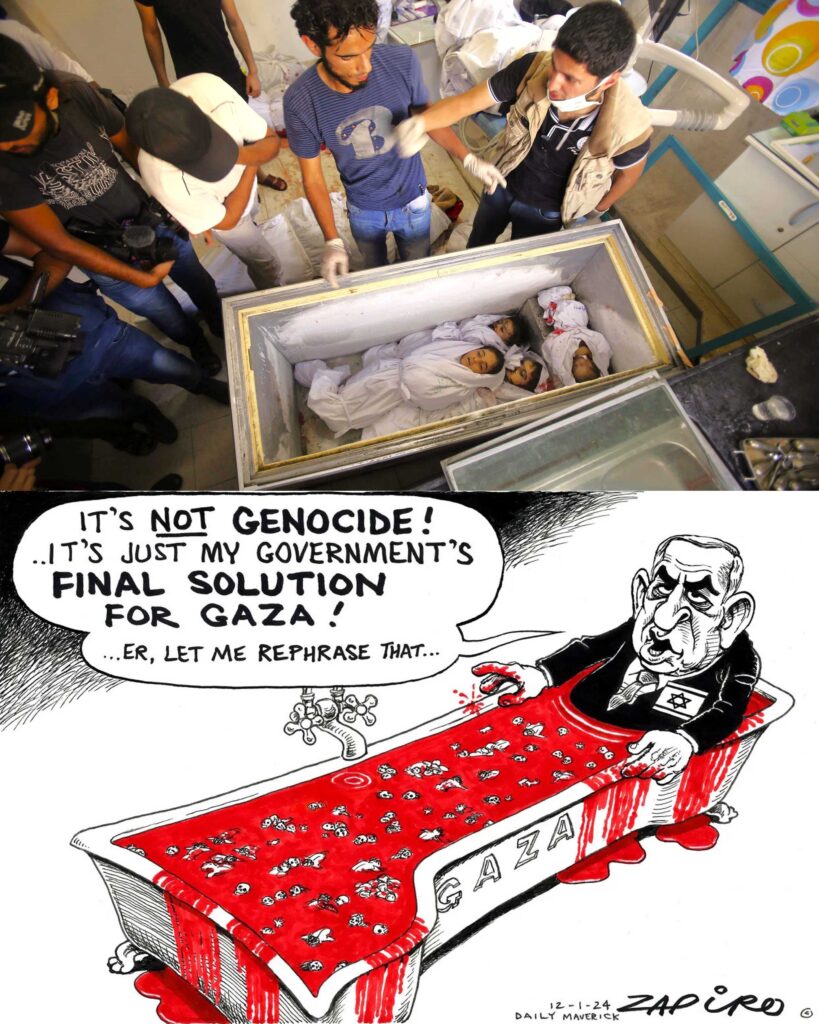
Photo Top: Multiple Bodies of Dead, Palestinian Babies, stored in a Cooler Box in an overwhelmed Gaza Hospital, in the mortuary, due to no fuel for the hospital generators, in the absence of electricity.
Photo Credit: The Japan Times, Japan
Photo Bottom: The Stark Reality of Palestinian Genocide and extrajudicial executions of civilians by IDF, orchestrated by Benjamin Netanyahu and President Isaac Herzog of Israel. Swiss prosecutors on 19th January 2024 confirmed that Israeli President Isaac Herzog had been the subject of criminal complaints during his visit to the 54th Summit of the World Economic Forum in Davos, as Israel finds itself accused of committing war crimes in Gaza. 18th January 2024.
Photo Credit: Zapiro, South African Political Cartoonist, for Daily Maverick 12 January 2024
References:
[1] Personal quote by author, January 2024
[2] https://www.transcend.org/tms/2023/12/the-forgotten-part-3-buddhist-directed-ethnic-cleansing-genocide-of-rohingyas-in-myanmar/
[3] https://www.transcend.org/tms/2023/12/the-forgotten-part-4-president-bashar-al-assad-syrian-civil-war-chief-peace-disruptor/
[4] https://www.transcend.org/tms/2023/11/the-forgotten-part-2-the-uyghurs-of-xinjiang-from-sinicization-to-genocide/
[5] https://www.transcend.org/tms/2023/11/the-forgotten-part-1-kashmir-heaven-on-earth-turned-hell-on-earth-by-21st-century-india/
[6] https://www.transcend.org/tms/2023/11/the-geopolitics-of-defining-genocides-massacres-targeted-extrajudicial-state-sponsored-murders-and-ethnophobia/
[7] https://www.transcend.org/tms/2023/11/the-7-oct-2023-hamas-invasion-of-israel-an-alternative-viewpoint-on-the-palestinian-genocide/
[8] https://www.transcend.org/tms/2023/10/the-religious-transformative-odyssey-of-bharat-part-2-manipur/
[9] https://www.transcend.org/tms/2023/09/heavenly-peace-of-the-oppressor-and-hellish-peace-of-the-oppressed/
[10] https://www.facinghistory.org/ideas-week/where-did-word-genocide-come
[11] https://www.transcend.org/tms/2023/11/the-forgotten-part-1-kashmir-heaven-on-earth-turned-hell-on-earth-by-21st-century-india/
[12] https://en.wikipedia.org/wiki/Benjamin_Netanyahu
[13] https://www.vox.com/world/2023/1/20/23561464/israel-new-right-wing-government-extreme-protests-netanyahu-biden-ben-gvir#:~:text=The%20%E2%80%9CChange%E2%80%9D%20government%20in%202021,an%20even%20more%20extreme%20government.
[14] https://en.wikipedia.org/wiki/Balfour_Declaration
[15] https://en.wikipedia.org/wiki/Raphael_Lemkin
[16] https://babel.hathitrust.org/cgi/pt?id=mdp.39015005077436
[17] https://en.wikipedia.org/wiki/War_crimes_in_the_Tigray_War#:~:text=Tigrayans%20were%20often%20killed%20en,forced%20disappearances%20and%20arbitrary%20detention.
[18] https://www.transcend.org/tms/2021/04/award-a-nobel-prize-for-peace-and-nurture-the-killing-fields-of-humanity/
[19] https://en.wikipedia.org/wiki/War_crimes_in_the_Tigray_War#:~:text=In%20January%202022%2C%20Amnesty%20International,often%20in%20front%20of%20their
[20] https://www.annefrank.org/en/anne-frank/go-in-depth/what-is-the-holocaust/
[21] https://www.un.org/en/genocideprevention/documents/atrocity-crimes/Doc.1_Convention%20on%20the%20Prevention%20and%20Punishment%20of%20the%20Crime%20of%20Genocide.pdf
[22] https://www.transcend.org/tms/2023/06/international-criminal-court-advancing-global-injustice-unaccountability-and-criminal-agenda-against-guardians-of-peace/
[23] https://law4palestine.org/the-gaza-genocide-case-a-comprehensive-overview-of-south-africas-legal-battle-with-israel-at-the-international-court-of-justice-highlights-and-faqs/
[24] https://rucore.libraries.rutgers.edu/rutgers-lib/45631/PDF/1/play
[25] https://en.wikipedia.org/wiki/Genocide_Convention#:~:text=The%20Convention%20defines%20genocide%20as,intended%20to%20destroy%20the%20group%2C
[26] https://www.washingtonpost.com/outlook/2022/03/15/genocide-ukraine-russia-zelensky/
[28] https://en.wikipedia.org/wiki/Rohingya_genocide#:~:text=to%20a%20genocide.-,Persecution%20and%20crackdown,130%20Rohingya%20people%20were%20killed.
[29] https://en.wikipedia.org/wiki/Wikipedia:Community_portal
[30] https://www.theholocaustexplained.org/what-was-the-holocaust/what-was-genocide/eight-stages-of-genocide/
[31] https://core.ac.uk/download/pdf/49241219.pdf
______________________________________________
 Professor G. Hoosen M. Vawda (Bsc; MBChB; PhD.Wits) is a member of the TRANSCEND Network for Peace Development Environment.
Professor G. Hoosen M. Vawda (Bsc; MBChB; PhD.Wits) is a member of the TRANSCEND Network for Peace Development Environment.
Director: Glastonbury Medical Research Centre; Community Health and Indigent Programme Services; Body Donor Foundation SA.
Principal Investigator: Multinational Clinical Trials
Consultant: Medical and General Research Ethics; Internal Medicine and Clinical Psychiatry:UKZN, Nelson R. Mandela School of Medicine
Executive Member: Inter Religious Council KZN SA
Public Liaison: Medical Misadventures
Activism: Justice for All
Email: vawda@ukzn.ac.za
Tags: Gaza, Genocide, Genocide Convention, Genocide Studies, Palestine, Rwanda
This article originally appeared on Transcend Media Service (TMS) on 29 Jan 2024.
Anticopyright: Editorials and articles originated on TMS may be freely reprinted, disseminated, translated and used as background material, provided an acknowledgement and link to the source, TMS: The Pathogenesis of a Genocide, is included. Thank you.
If you enjoyed this article, please donate to TMS to join the growing list of TMS Supporters.

This work is licensed under a CC BY-NC 4.0 License.